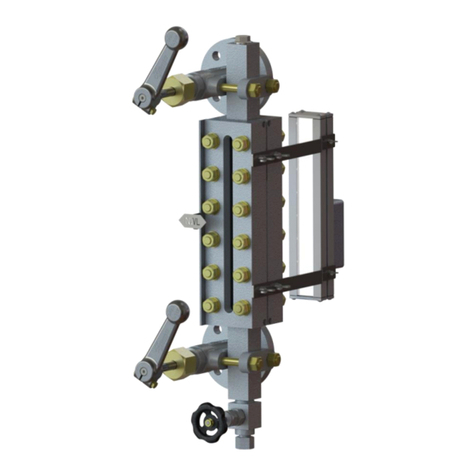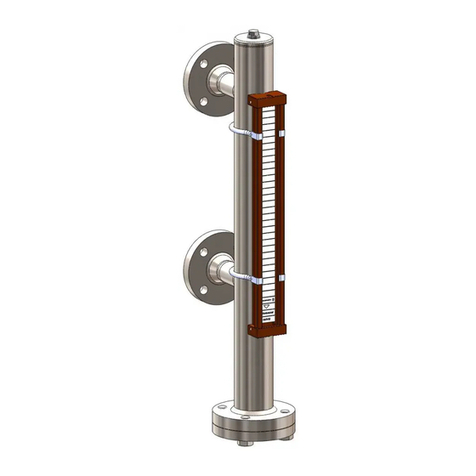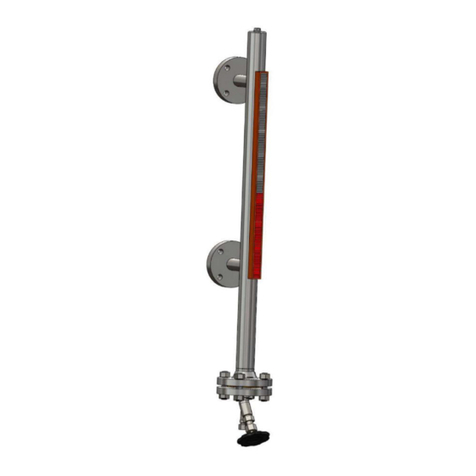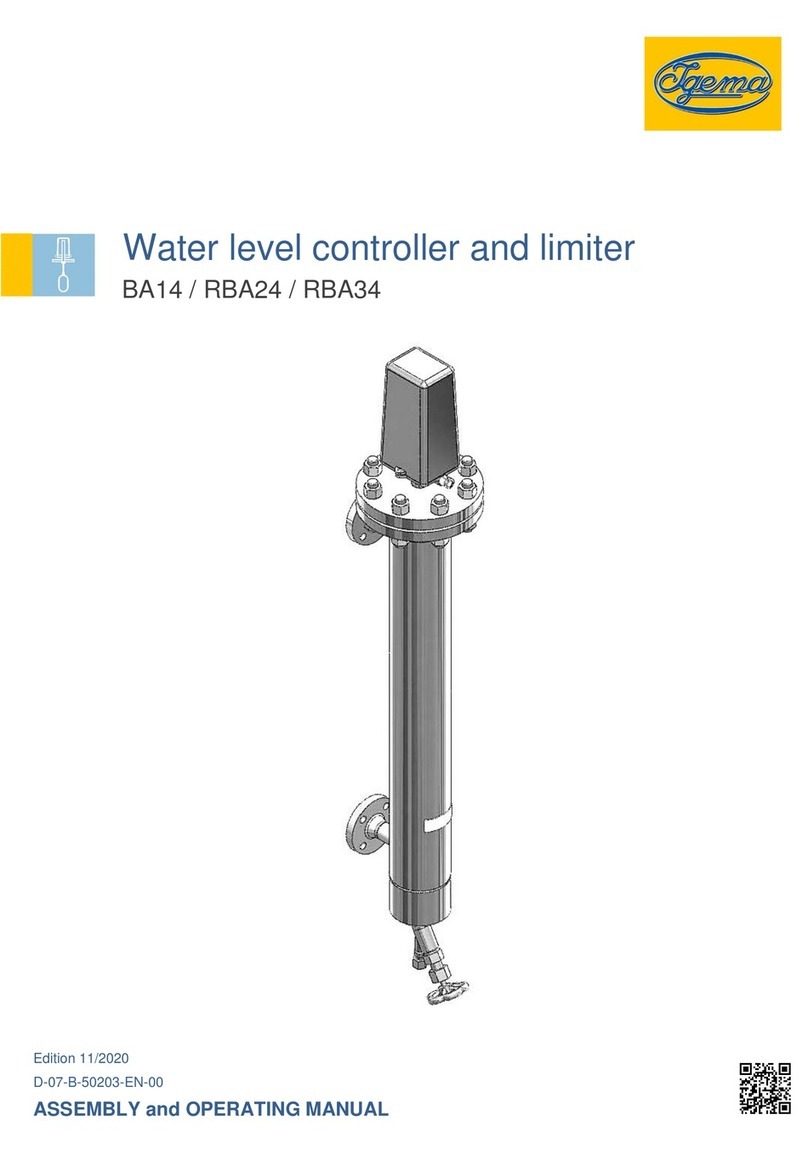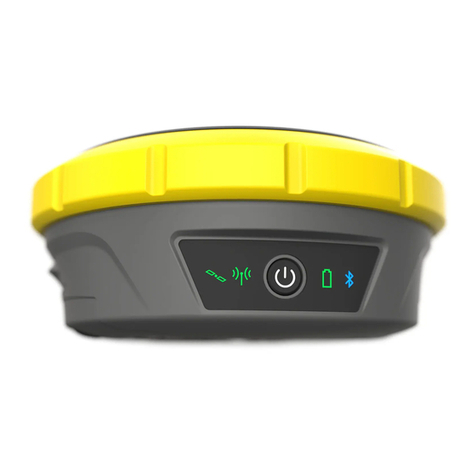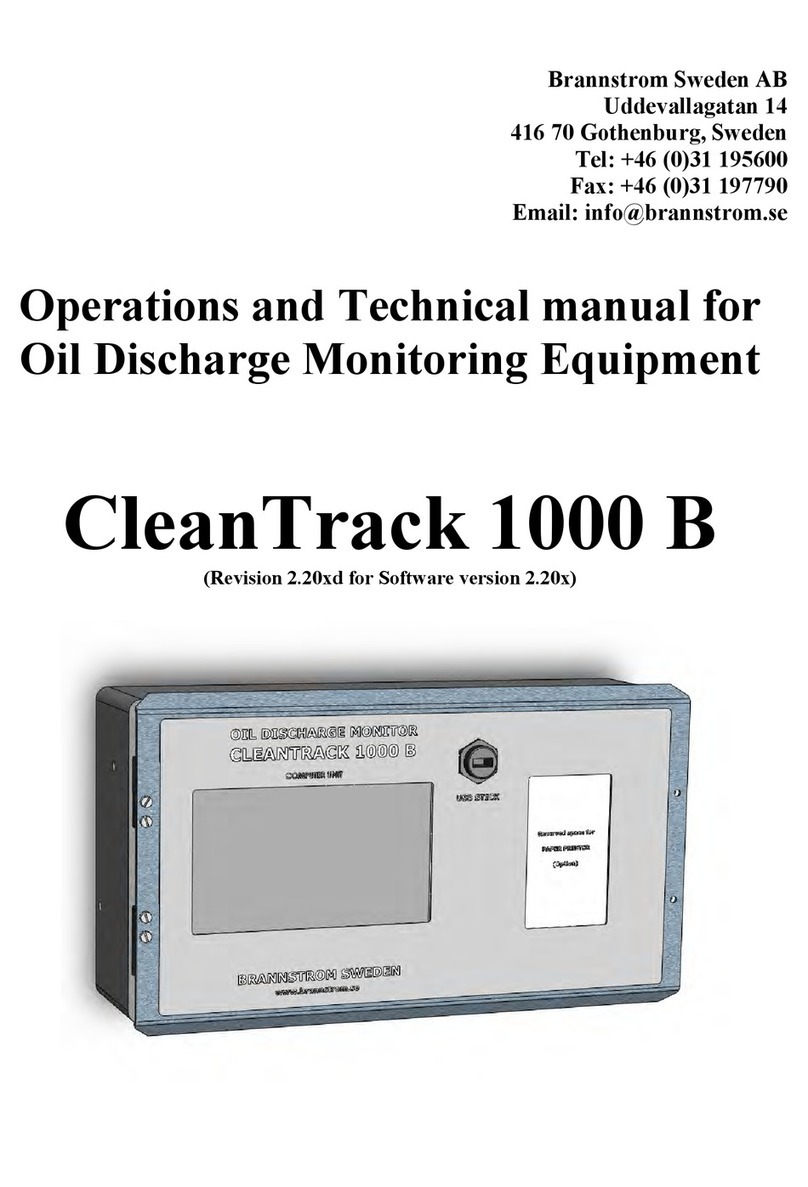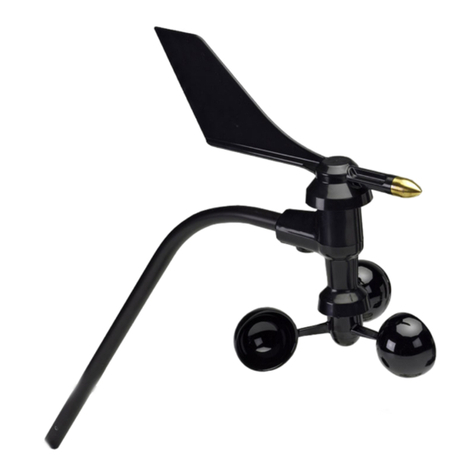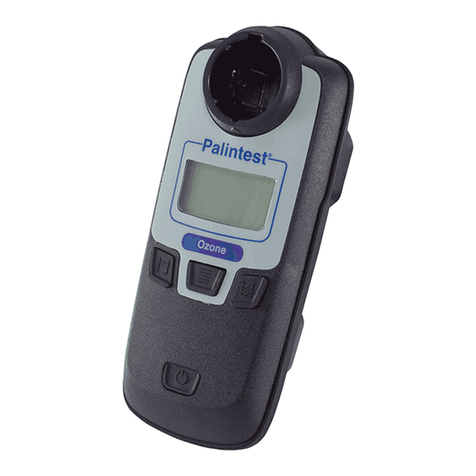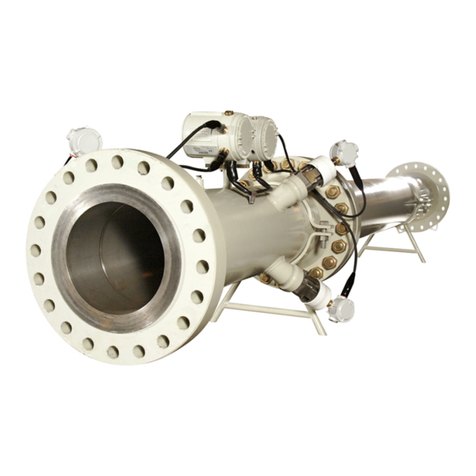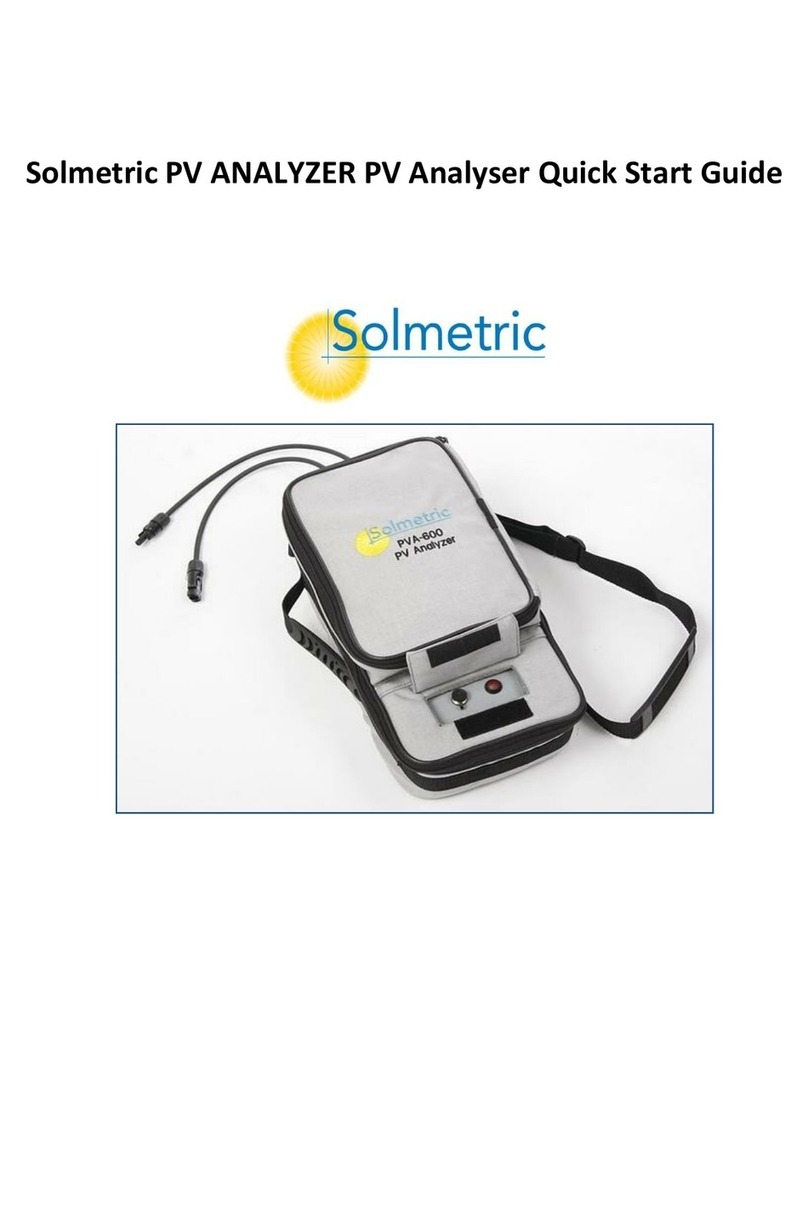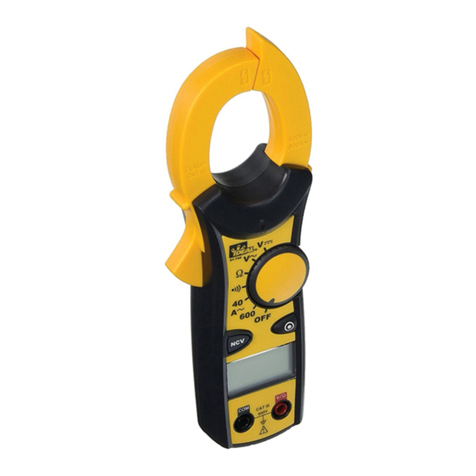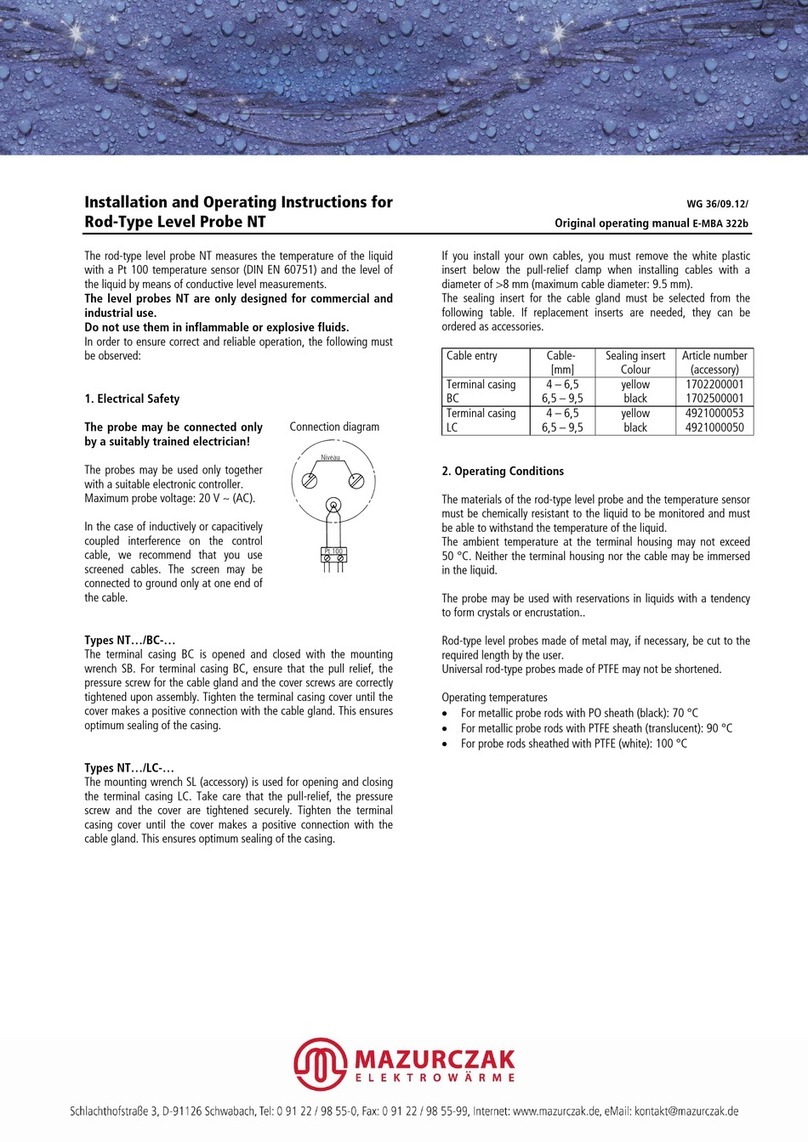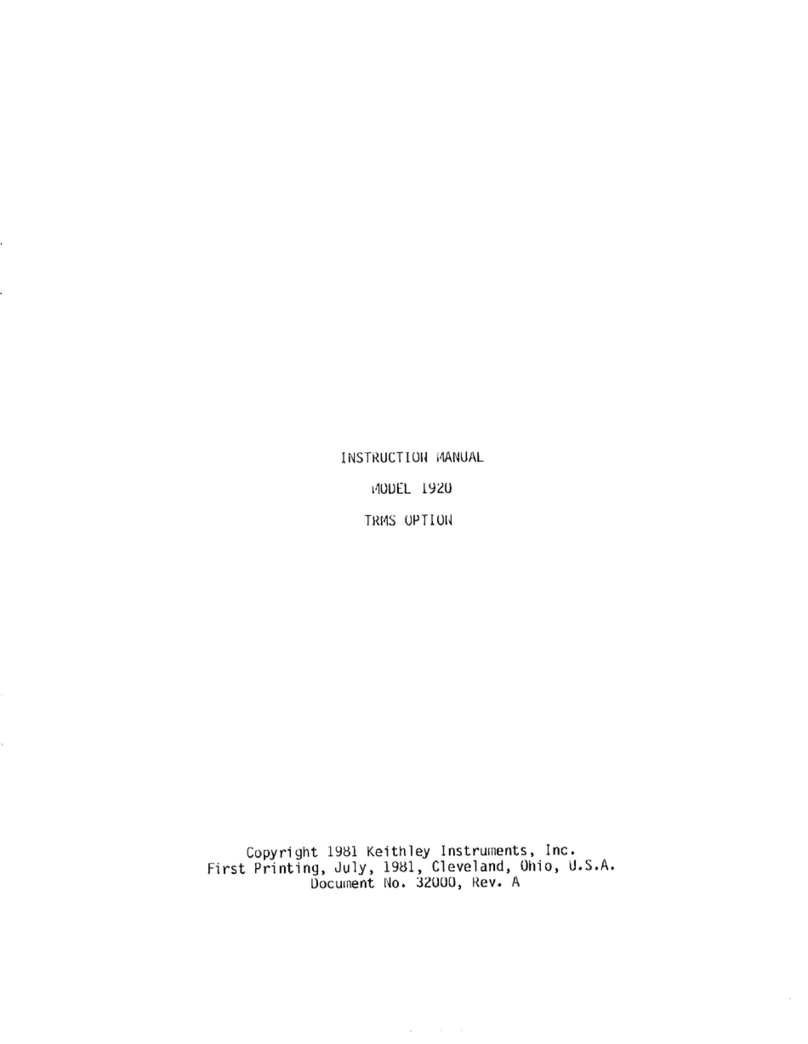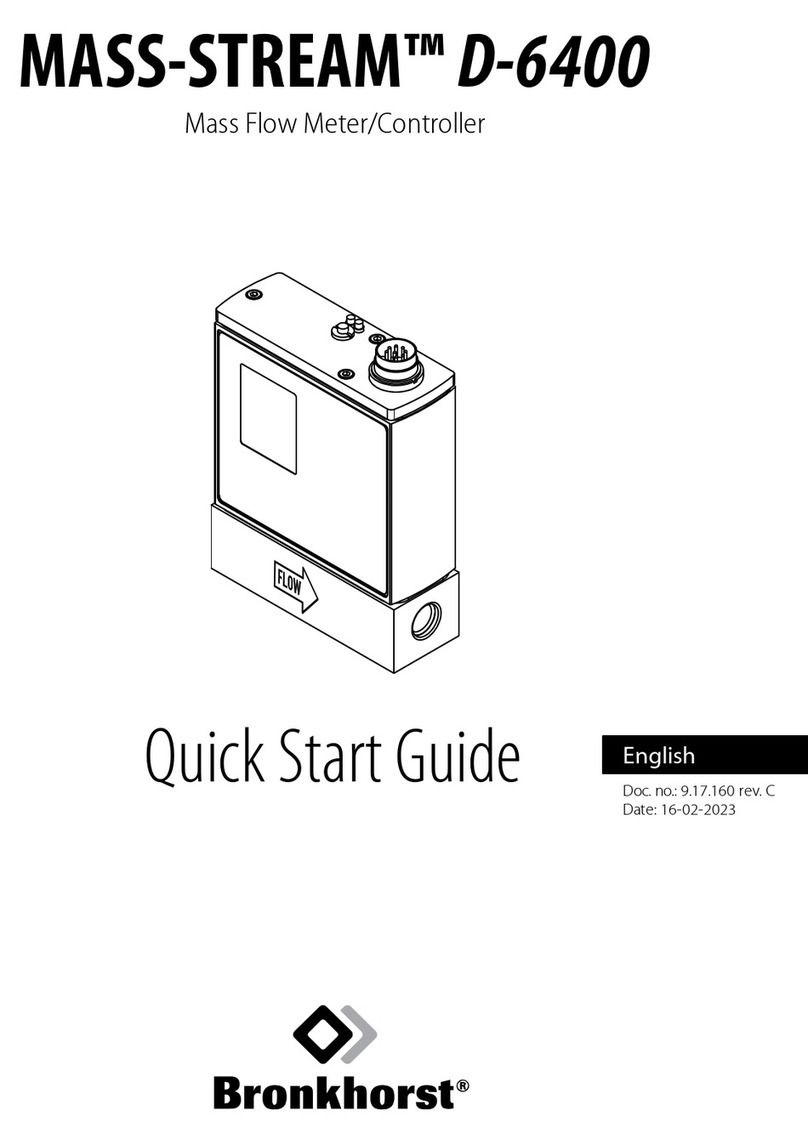Igema G User manual

Edition 03/2021
D-05-B-51518-EN-01
Installation and operating instructions
Type G
Remote level gauge

2
Product philosophy
Thank you for placing your trust in IGEMA and deciding in favour of one of our
high-quality products.
For more than 100 years, measuring and control systems have been developed,
produced and sold worldwide under the IGEMA brand name.
“Steam is our passion” and we offer you the entire programme for the safe and
economic operation of your plants, especially in the steam and condensate sector.
Please read the installation and operating instructions carefully to ensure a safe and
reliable operation.
In addition to the information on installation and operation, you will also find important
information on maintenance, care, safety and value retention of your measuring and
control system.

3
Table of contents
1. Important safety instructions.............................................................................6
1.1 Symbols used in these instructions...................................................................6
1.2 Intended use of the device................................................................................7
1.3 Safety at work ...................................................................................................8
1.4 Safety instructions for this device......................................................................9
1.5 Exclusion of liability...........................................................................................9
2. Contents of packing..........................................................................................10
3. Important information.......................................................................................10
3.1 Intended use ...................................................................................................10
4. Explanations......................................................................................................11
4.1 Scope of supply ..............................................................................................11
4.2 Function..........................................................................................................11
4.3 Versions..........................................................................................................11
5. Technical data ...................................................................................................12
5.1 Version............................................................................................................12
5.2 Type of connection..........................................................................................13
5.3 Materials .........................................................................................................13
5.4 Application limits .............................................................................................13
5.5 Corrosion resistance.......................................................................................13
5.6 Identification plate / Marking ...........................................................................13
6. Construction......................................................................................................14

4
Table of contents (cont.)
7. Assembly...........................................................................................................15
7.1 Version with flange..........................................................................................15
7.2 Version with buttwelding end ..........................................................................15
7.3 Remote level gauge (see sketch chapter 6)....................................................15
7.4 Illumination device ..........................................................................................16
8. Commissioning .................................................................................................16
8.1 Before commissioning.....................................................................................17
8.2 Cleaning of connection lines (f) (see sketch chapter 5)...................................18
8.3 Commissioning of remote level gauge............................................................19
8.4 Adjustment of the indicator liquid level............................................................19
9. Operation...........................................................................................................19
9.1 Operating monitoring (see sketch chapter 6)..................................................19
9.2 Decommissioning of boiler..............................................................................20
10. Maintenance ......................................................................................................20
10.1 Cleaning of connection lines (f) (see sketch chapter 6) ..............................21
10.2 Cleaning of level gauge ..............................................................................21
10.3 Replacement of glasses..............................................................................21
10.4 Tightening torques......................................................................................22

5
Table of contents (cont.)
11. Shutoff valves....................................................................................................22
11.1 General information and operating instructions ..........................................22
11.2 Construction of valves ................................................................................22
11.3 Indicator valve (h, j) ....................................................................................23
11.4 Main shutoff valve (c, g)..............................................................................24
12. Case of damage.................................................................................................25
13. Spare parts ........................................................................................................25
13.1 Remote level gauge (see sketch chapter 6)................................................26
13.2 Main shutoff valve.......................................................................................27
13.3 Indicator valve.............................................................................................27
14. Decommissioning .............................................................................................28
14.1 Disposal......................................................................................................28
15. Manufacturer´s declaration ..............................................................................28

6
1. Important safety instructions
KEEP THESE INSTALLATION AND OPERATING INSTRUCTIONS IN A SAFE PLACE!
Commissioning as well as maintenance and repair work may only be carried out by qualified
persons in compliance with the installation instructions given in this operating manual. The
correct installation, commissioning, maintenance and operation of the device presupposes that
the person in charge is familiar with measurement and control systems and complies with the
general installation and safety instructions. In addition, the correct and intended use of tools
and the handling of safety devices must be ensured. Unqualified persons must not be assigned
the above tasks!
IGEMA GmbH accepts no liability for damage to property or personal injury caused by
unqualified persons or by failure to observe these installation and operating instructions. If no
sufficiently qualified person can be found, IGEMA GmbH can be commissioned with the
installation/maintenance.
1.1 Symbols used in these instructions
In the following installation and operating instructions, safety instructions are marked with the
following symbols:
Danger
This symbol and signal word refer to a potentially
hazardous situation which could result in death or
injuries if ignored.
Caution electrical voltage
This symbol and signal word indicate live parts
with an immediate danger of death from electric
shock.
Caution hot
This symbol with a signal word indicates a
potentially hazardous situation that can result in
severe burns and scalds all over the body.

7
Caution
This symbol and signal word refer to a potentially
hazardous situation which could result in
personal injury, property and environmental
damage if ignored.
Caution
This symbol and signal word refer to a potentially
hazardous situation which could result in damage
to the equipment if ignored.
Info
This symbol indicates useful information and
recommendations as well as measures that will
prolong the value of your measuring and control
system.
1.2 Intended use of the device
Use these installation and operating instructions, the identification on the rating
plate (see 5.6) and the technical data sheet to check whether the device is
suitable for the intended use/application. The device complies with the
requirements of the European Pressure Equipment Directive 2014/68/EU.
The device may only be used to indicate fill levels on containers.
The maximum values of the pressure and temperature range of the device must be checked
before installation. If the maximum allowable operating values of the device are lower than
those of the system on which it is to be installed, protective instruments for the device, such
as pressure reducers or similar, must be provided to avoid limit situations. The device may
only be used in accordance with the information in these installation and operating instructions
or for the parameters and applications agreed in the supply contract. (see rating plate, 5.6)
The operator of the direct water level indicator is obliged to familiarise himself on the
compatibility of the medium and the device. In case of doubt, contact the relevant installation
manager or site manager.
The correct installation position, alignment and flow direction of the device must be observed!
Before installing the IGEMA product on boilers or containers, it is essential to remove all
protective covers and, if necessary, the protective film from rating plates and sight glasses.
Caution

8
1.3 Safety at work
Before installation or carrying out maintenance work on the device, safe access
must be ensured and a secure working area with sufficient lighting must be
defined and marked out. Always use lifting equipment for heavy loads!
Before starting any work, carefully check which liquids or gases are or have been in the
pipeline. (flammable substances, irritating substances, substances hazardous to health) When
opening or dismantling the device, residues of the medium can escape. Subsequent fumes
are also possible in unpressurized and cold systems. Use designated PPE such as safety
goggles and respiratory protection!
Special attention must be paid to the condition of the environment around the installation or
maintenance site. Be aware of e.g.: potentially explosive atmospheres, lack of oxygen in tanks
and pits, dangerousgases/liquids, extreme temperatures, hot surfaces, firehazard (e.g. during
welding) and moving machine and system components. Protect yourself from excessive noise
by taking the required protective measures.
For all maintenance work or new installations, on new or existing boilers or vessels, it is
imperative to check that the boiler or vessel has been depressurised and that the pressure has
been safely reduced to atmospheric pressure. In principle, no system should be regarded as
unpressurized even if indicated by pressure measuring devices such as pressure gauges or
sensors. When releasing the pressure, make sure that no persons are in the release area.
Carefully check whether you and/or other persons in the vicinity need PPE to protect yourself
from external influences such as high and low temperatures, radiation, noise, danger to eyes,
loose objects that can fall down or chemicals.
There is always a risk of injury when handling large and/or heavy equipment. Observe the load
handling regulation as a minimum requirement for working with loads. Avoid handling the
device with your own physical force, e.g. by lifting, pulling, carrying, pushing or supporting it,
especially to prevent back injuries. Use lifting equipment to move heavy and bulky equipment
in accordance with Article 1, Section 2 of the German Load Handling Regulation
(LasthandhabV).
Under normal operating conditions the surface of the device can become very
hot! Under the maximum operating conditions, the surface temperature can
exceed 350°C. After shutting off or, if necessary, shutting down the boiler, wait
until the temperature has normalized to room level. To avoid the risk of burns
and scalds, always use PPE including safety goggles!
Danger
Caution
hot!

9
1.4 Safety instructions for this device
These installation and operating instructions are an integral part of the device
and must be forwarded to the responsible departments "Goods inward,
Transport, Installation, Commissioning and Maintenance". They must be kept in
such a way that the technical staff have access to these documents at all times.
If the device is passed on to a third party, these installation and operating
instructions must also be included in the national language of the third party.
Avoid shocks and hard contact during transport, as this can lead to damage. During
intermediate storage, the device must be kept dry and secured against damage.
When servicing the unit, make sure to use sharp-edged internal parts and avoid shards of
broken glass. There is a risk of cutting hands and arms! Always wear work gloves when
changing packing, valve seat and valve plug.
For units with a dead weight of 30 kg or more, the customer must provide adequate support
(e.g. via a spring suspension device, etc.). This can be attached to the holding strap/eyelet on
the device.
When returning goods to IGEMA GmbH, the applicable safety and environmental laws
according to GGVSEB [German ordinance on the national and international carriage of
dangerous goods by road, rail, and inland waterways] must always be observed. If there are
any risks to health or the environment due to residues or the device has a mechanical defect
this must be indicated when returning the device and the necessary precautionary measures
must be taken. If the returned goods are devices that have come into contact with or contain
hazardous substances, a safety data sheet must be enclosed, and the goods must be clearly
marked. In addition, the hazardous substance must be reported to the logistics service
provider.
1.5 Exclusion of liability
IGEMA GmbH Mess- und Regelsysteme will assume no liability if the above regulations,
instructions and safety precautions are not observed and followed. If they are not expressly
listed in the installation and operating instructions, changes to an IGEMA device are carried
out at the risk of the user.
Caution

10
2. Contents of packing
Remote level gauge:
The level gauge is delivered as unit A, B and C.
Unit A consist of: •Level gauge (k)
•Indicator valves (h, j)
Unit B consist of: •Upper main shutoff valve (c) with condenser (b)
•Lower main shutoff valve (g)
Unit C consist of: •Illumination device (p)
3. Important information
The remote level gauge is for measurement and control purposes and
must only be used to display fill levels on a tank. Here care must be taken
that pressure and temperature do not exceed the maximum limitations of
use. These can be found on the identification plate.
The operator of the remote water level gauge is responsible for the
intended use of the indicator.
Note!
For displays weighing 30 kilograms or more, the customer must provide
sufficient support (e.g. by spring hangers or similar).
3.1 Intended use
Remote level gauge:
The remote level gauge type GS can be used for every steam generator according to TRD
401 except continuous steam generators.
In the sight opening, a float indicates the water level in the passage
between water and steam.
Applied rules as per TRD/Ad2000 or ASME-Boilers.
Caution
Caution
Caution

11
4. Explanations
4.1 Scope of supply
The type FA GS is used to indicate the water level of steam generators.
4.2 Function
The level gauge works according to the physical low of the communicating tubes.
The geodetic pressure difference of two water columns is transferred to a transparent
separating blue liquid in the remote level gauge. This liquid is not soluble in water and non-
toxic.
A signal float swimming on separating liquid reports water level in steam drum on a scale of
1:1 or on a reduced scale.
4.3 Versions
Single show length

12
5. Technical data
5.1 Version
One sight opening

13
Sight openings:
All. pressure
PS
[bar]
10-50
80-200
Sight opening
S
[mm]
470 (on request)
---
310 or 390
All. temperature range on the
"remote indicator" body and on
the indicator valve
TS
[°C]
2 to 40
5.2 Type of connection
Standard : Flanges according to DIN
On request : flanges according to ASME
Buttwelding end according to DIN or ASME
5.3 Materials
Parts in contact with the medium: C steel or stainless steel according to DIN or ASME.
Pressure holding components: C steel or stainless steel according to DIN or ASME.
5.4 Application limits
Max. all. pressure PS
[bar]
10-200
Max. all. temperature TS
[°C]
40
5.5 Corrosion resistance
The safety of the unit is not influenced by corrosion if it is used as intended.
5.6 Identification plate / Marking
The following data are indicated on the identification plate according to EN 19:
* marking depending on the realization
A Date of manufacture D Max. all. Temperature G TAG-Nr. (optional)
B Type of unit E Nominal pressure (not listed)
C Max. all. Pressure F Nominal diameter
IGEMA GmbH
Mess- und Regelsysteme
Antwerpener Straße 1
Germany –48163 Münster
G

14
6. Construction
Remote level gauge G
Level gauge cross-section
(a) Vent plug (k) Level gauge (1) Sealing
(b) Condenser (I) Indicator fluid (2) Glass
(c) Upper shut-off valve (m) Plug (3) Sealing
(d) Bolting (n) Plug (used as cushion)
(e) Balance pipe (o) Supporting clamp (4) Pressure plate
(f) Connection line (p) Illumination device (5) Cover screw
(g) Lower shut-off valve (q) Drain opening (6) Cover rail
(h) Indicator valve (r) Adjusting screw (7) Hexagon nut
(j) Indicator valve
Steam
Water
Separating liquid
Transmission range E
at the level gauge
Sight opening S

15
7. Assembly
7.1 Version with flange
•Respect installation position!
•Remove protection caps from connection flanges. Caps only serve as transport
protection.
•Ensure that sealing surfaces are clean and undamaged.
•Use sealing material as per EN1514 and screws as per DIN2510 or DIN974
(material 1.7709).
•Mount main shutoff valves.
7.2 Version with buttwelding end
•Einbaulage beachten!
•Schutzkappen entfernen. Die Schutzkappen dienen nur als Transportsicherung.
•Montage nur mit: Schweißprozess 111 (Lichtbogenhandschweißen) und 141 (Wolfram-
Inertgasschweißen).
7.3 Remote level gauge (see sketch chapter 6)
•Fix level gauge (k) via supporting clamp (o).
•Connect main shutoff valves (c) and (g) on boiler studs.
•Weld on balance pipe (e) and lay connection lines (f) with constant slope to avoid air
locks during operation.
•Weld on connection bolting (d) on the ends of connection lines (f). Check sealing and
sealing surface of the bolting (d).
•Tighten firmly bolting (d) on condenser (b) and shutoff valve (g).
•Mount illumination device (p) and carry out electrical connection observing the VDE 0100
and the current regulations.
•Boiler manufacturer or operator have to ensure that filling (separating liquid and water) in
level gauge (k), connection lines (f) and condenser (b) can neither freeze nor vaporise.

16
7.4 Illumination device
Only use the lamp in explosion-proofed rooms!
Only skilled and qualified electricians may carry out assembly and
connection of the lamps!
Never insulate illumination devices!
Mount the illumination device with the fixing elements on the level gauge.
8. Commissioning
Commissioning and maintenance must be carried out by qualified
personnel! If no sufficiently qualified person can be employed, IGEMA
GmbH can be commissioned to carry out the commissioning. In principle
IGEMA GmbH recommends commissioning the indicator at the same time
as the boiler (item 8.2). If it is not possible to commission the indicator
according to item 8.2, the indicator canbe commissioned with the boiler under pressure
and temperature (item 8.3)
All liquid level gauges are subjected to 100% pressure testing before delivery. In individual
cases, material settling may occur during transport, longer storage or during assembly. All
screw connections must therefore be checked for tight fit and appropriate torque (see following
text).
8.1 Before commissioning
Before commissioning, check whether any transport damage has occurred. If the delivered
Igema products show transport damage, please contact our SERVICE department
immediately.
Furthermore, due to possible material settlements, all screw connections must be checked for
the correct tightening torque Md max according to the table in chapter 10.4!
Tightening sequence to be observed for the cover rails is presented
below!
Non-compliance may result in leakage, glass and mica break.
The following tightening sequence must be ensured at the cover rails (drawing below). Non-
compliance can lead to leaks, which are not covered by the warranty. Tighten the screw
connection to the tightening torque Md max. according to the table (see item 10.4).
Danger
Caution
Danger

17
uneven number even number screw rows
At the latest 24 h after commissioning, the screw connections must be checked and tightened
max. again with the torques specified above in the listed tightening sequence Mdmax (see item
10.4)! This should be repeated until the bolts permanently hold the specified torques.
The union nuts of the valves must be tightened so that no leakage occurs at the spindle and
the handwheel / hand lever can still be turned.
Note!
After commissioning, slight leakscan occur in the valves, but these will reappear
after a short time due to temperature and pressure.
8.2 Cleaning of connection lines (f) (see sketch chapter 5)
•Close main shutoff valves (c) and (g). Detach connection lines (f) on indicator valves (h)
and (j) and on bolting (d) and bend a little to the side.
Cleaning of connection lines can be made in two ways:
Ensure that nobody stays next to detached bolting of
indicator valves (h) and (j)!
a. Remove vent plug (a) and purge connection lines (f) with water through this opening.
b. Bring boiler to operating condition with firmly tightened vent plug (a) and purge
connection lines (f) by opening and closing several times main shutoff valves (c) and (g).
•Tighten firmly detached connection lines on indicator valves (h) and (j).
Danger
Info

18
8.2 Commissioning of remote level gauge
Fill level gauge and connection lines with water and indicator liquid in the following order to
avoid air locks.
•Close tightly main shutoff valves (c, g) and indicator valves (h, j).
Check bolts of adjusting screw (r) and plug (m).
Unscrew plugs (a, m and n).
•Fill in water at plug (n) on the indicator valve (j) until the water level is in the highest
visible area of the indicator. Then fill in the indicator liquid until the level of the indicator
liquid is at the highest visible point of the indicator. Continue to fill in a quantity of approx.
10 cm³ of indicator liquid.
The marking of the working material "indicator liquid" is visible on the container.
Observe the safety advice on the container of the indicator liquid.
These are shown on the container of the indicator liquid and in the safety
data sheet.
Use the liquid supplied in the container within one year.
•Fill in clean water up to overflowing at plug (n) on indicator valve (h). Firmly tighten plug
(n) with sealing.
•Fill in clean water up to overflowing at plug (n) on indicator valve (j). Firmly tighten plug
(n) with sealing.
•Slowly fill in clean water up to overflowing at vent plug (a) of main shutoff valve (c).
Both shutoff valves (c, g) must be closed. Tighten vent plug (a) with sealing
•After having reached a minimum operating pressure of 2 bar, open valves in the
following order: c, g, h and j.
•Check all screw connections for tightness during the period of boiler start-up to operating
condition and retighten if necessary. After a few hours of operation, check all screw
connections again for tightness and retighten them.
Danger

19
8.3 Adjustment of the indicator liquid level
The level of the indicator liquid is adjusted during boiler operation at medium water level.
By repeatedly opening the regulating screw (r) for a short time, enough display liquid is
drained off at the drain opening (q) until the display corresponds to the water level of the
direct water level indicator.
If the deviation is greater, readjustment must be carried out in stages, i.e. with small pauses.
The indicator liquid to be drained off must be collected in a container, taking into account the
safety advice of the working material "indicator liquid". The marking of the working material
is visible on the container.
If, as a result of an error, too much liquid has been drained or too little
has been poured in, proceed as in point 8.2.
9. Operation
9.1 Operating monitoring (see sketch chapter 6)
The display liquid level must be compared with the water level on the direct water level
indicator at regular intervals.
If not matched, the following causes may occur:
•Indicator valves (h, j) are not opened.
Open first indicator valve (h) and then valve (j).
•Main shutoff valves (c, g) are not opened.
Close opened indicator valves (h, j). Opening valves in the following order: c, g, h and j.
•Condenser (b) is not hot enough; no condensation.
Carefully turn vent plug (a) once and vent condenser (b). Firmly close vent plug again.
•Operating errors in observing the sequence of opening the valves.
Drain the indicator liquid according to point 8.2.
Subsequent measures according to point 8.2 / 8.3.
•Liquid level comparatively too high
Adjustment following to point 8.3.
Regularly check tightness of valves (c, g, h and j) and retighten stuffing box if necessary.
Danger

20
To relieve the stuffing box of the indicator valves (h, j) and main shut-off
valves (c, g) during operation, open the valve stems as far as they will
go.
9.2 Decommissioning of boiler
•Close indicator valves (h, j) in any case of decommissioning.
In case of longer boiler stagnation, also close shutoff valves (c, g).
•Open valves for re-commissioning in following order: c, g, h and j.
•If boiler is in operating condition, pay attention that operating temperature on condenser
(b) is sufficient. Vent condenser (b) as per 9.1 if necessary.
10. Maintenance
Carry out maintenance works only if connection lines (f) are empty and
pressureless!
Beware of escaping steam!
It is assumed that the person charged with the maintenance tasks is fully conversant with
measurement and control systems. Untrained persons must not carry out maintenance work!
If there is no adequately qualified person available, IGEMA GmbH can be brought in to service
your measurement and control system.
When replacing components, it must be ensured that only original IGEMA GmbH parts
are used.
Any warranty is void if components from other manufacturers are used.
Preventive Maintenance
The following points should be observed to maximize gauge life:
Proper cleaning and maintenance of level gauges in steam service is vital for enhanced
performance and service life. The gaskets and mica shields shall always be replaced during
maintenance, even if they appear to be in perfect condition. Gaskets relax and can harden
over time while defects in mica (i.e., chips or scratches) become points of high stress
concentration. Even with no visible defects, a used glass has surface stresses induced from
the original assembly and pressurization of the gauge. If reassembled, the gaskets and
sealing surfaces will apply new stresses, which are likely to break the mica either during
assembly or when the gauge is pressurized.
Caution
Danger
Table of contents
Other Igema Measuring Instrument manuals
Popular Measuring Instrument manuals by other brands
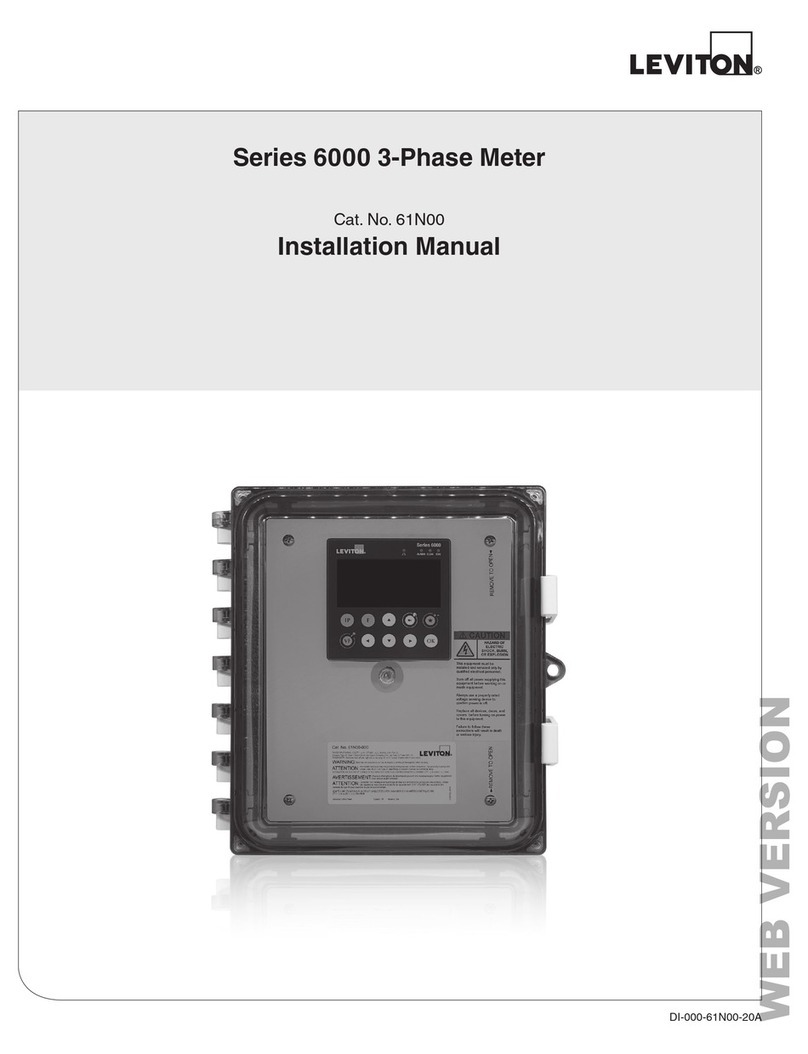
Leviton
Leviton VerifEye 6000 Series installation manual
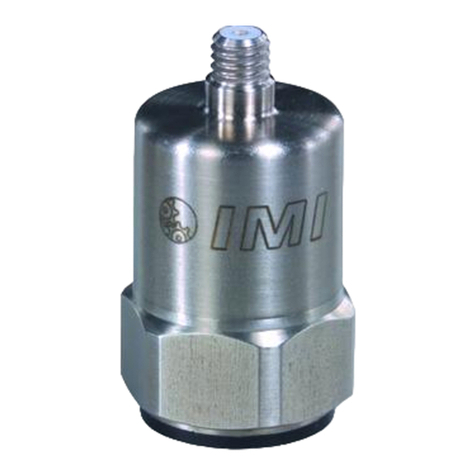
PCB Piezotronics
PCB Piezotronics IMI Sensors 621B41 Installation and operating manual
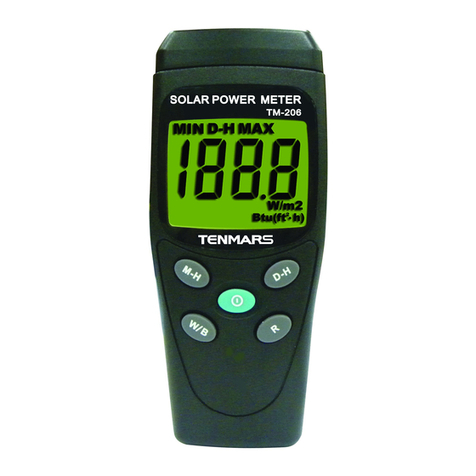
Tenmars
Tenmars TM-206 user manual
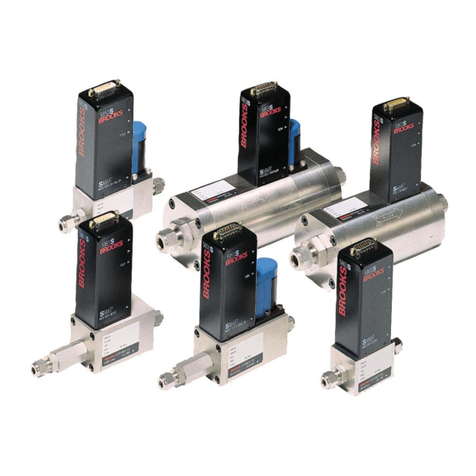
Brooks
Brooks Smart Series Installation and operation manual
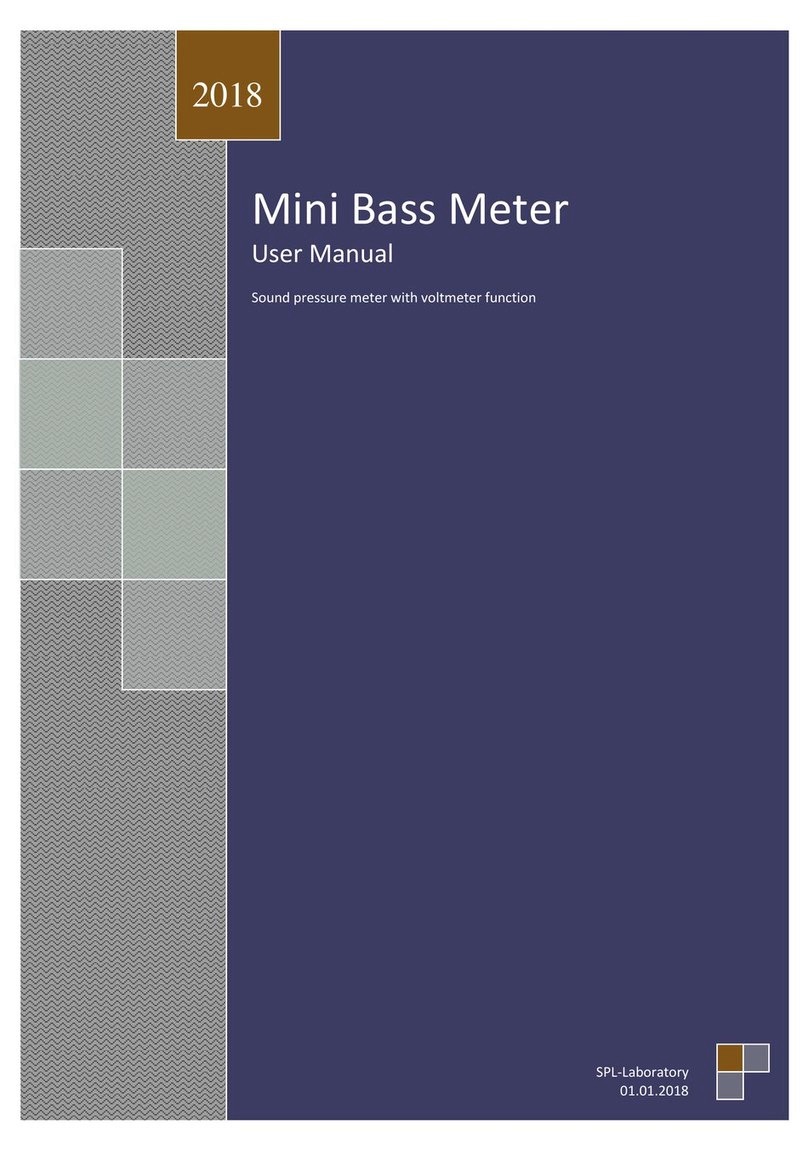
SPL-Laboratory
SPL-Laboratory Mini Bass Meter 2018 user manual
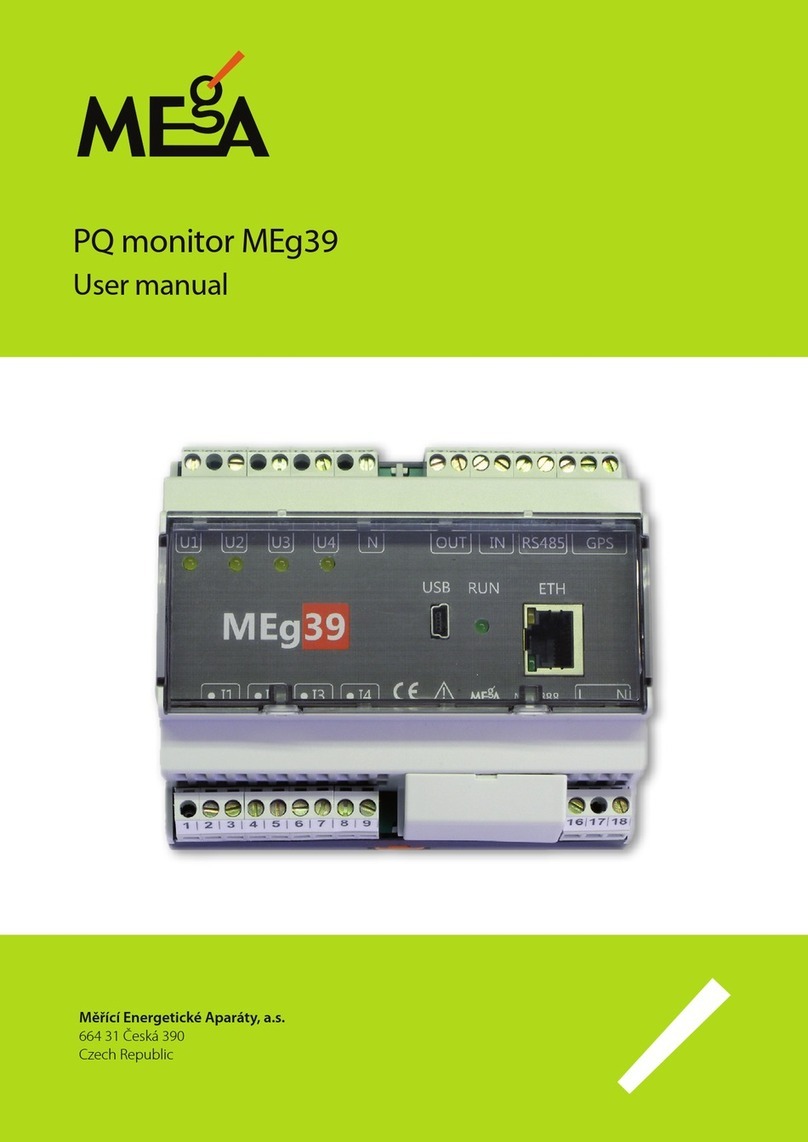
Mega
Mega Meg39 user manual
